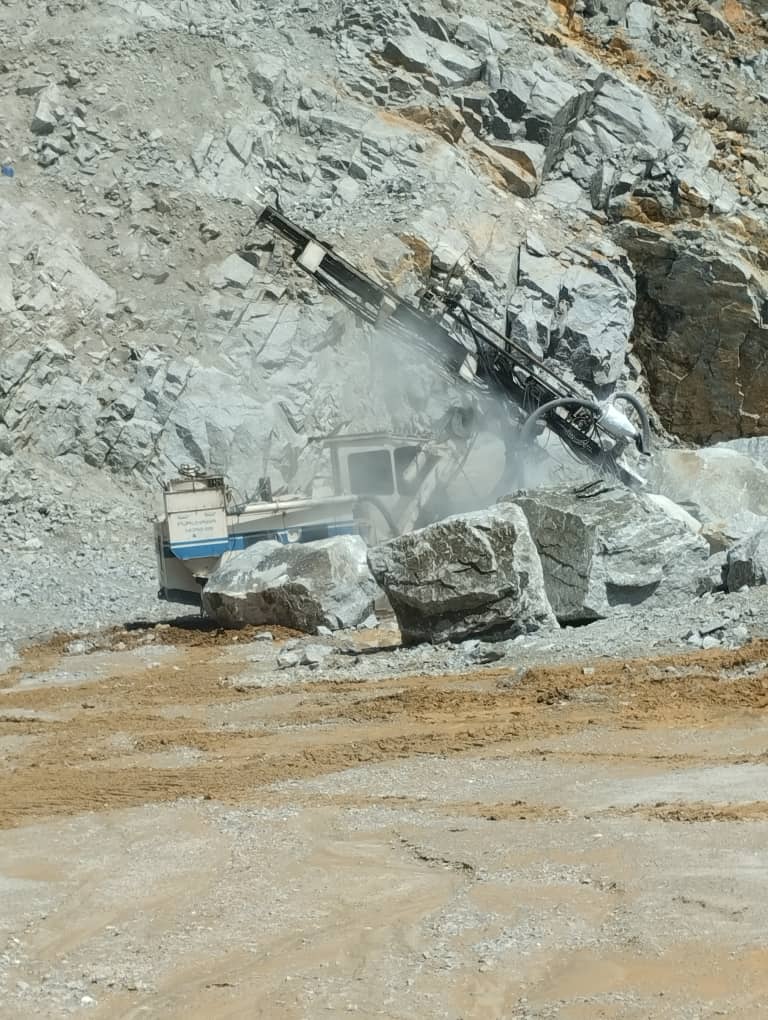Site Selection: The first step in quarrying granite is selecting a suitable site. Factors such as proximity to markets, quality of the granite deposit, accessibility, and environmental considerations are taken into account.
Clearing the Land: Before quarrying can begin, the land must be cleared of any vegetation, topsoil, and other debris. This is usually done using heavy machinery such as bulldozers and excavators.
Drilling and Blasting: Once the site is cleared, holes are drilled into the rock using specialized equipment. These holes are filled with explosives, which are then detonated to break the granite into manageable pieces. Controlled blasting techniques are often employed to minimize damage to the surrounding rock and to ensure worker safety.
Extraction: After blasting, the fragmented granite is loaded onto trucks or conveyors and transported to the processing plant. Large blocks of granite may need to be further broken down into smaller pieces using saws or chisels.
Cutting and Shaping: At the processing plant, the granite blocks are cut into slabs of the desired thickness using diamond wire saws or gang saws. These slabs are then shaped and finished according to customer specifications using saws, grinders, and polishing equipment.
Quality Control: Throughout the quarrying and processing stages, quality control measures are implemented to ensure that the granite meets the required standards for strength, durability, and appearance. This may involve conducting tests on samples of the stone, inspecting the finished slabs, and addressing any defects or inconsistencies.
Transportation and Distribution: Once the granite has been processed and inspected, it is ready to be shipped to customers. Depending on the location of the quarry and the destination of the stone, transportation may involve trucks, trains, ships, or a combination of these methods.
Site Rehabilitation: After the quarrying operations are complete, efforts are made to rehabilitate the site and restore it to a natural or usable condition. This may include regrading the land, replanting vegetation, and implementing erosion control measures to minimize environmental impact.
Overall, the quarrying process involves a combination of heavy machinery, specialized equipment, and skilled labor to extract, process, and distribute granite efficiently while minimizing environmental impact.
Specifically in drilling and blasting
Drilling:
Drilling is the initial step in preparing the granite for blasting. Specialized drilling equipment, such as rotary drills or hammer drills, is used to create holes in the rock. These holes are strategically placed based on factors such as the geological structure of the granite deposit, the desired size of the resulting fragments, and safety considerations. The diameter, depth, and spacing of the drill holes are carefully planned to optimize the blasting process and ensure maximum efficiency. Modern drilling equipment may use pneumatic, hydraulic, or electric power sources to drive the drill bits into the rock.
Loading the Holes:
Once the drill holes are completed, they are loaded with explosives. Explosive materials such as dynamite, ANFO (ammonium nitrate/fuel oil), or emulsion explosives are commonly used in quarry blasting operations. Explosive charges are carefully measured and placed in the drill holes to achieve the desired fragmentation of the granite. Initiating devices, such as detonators and blasting caps, are inserted into the explosive charges to initiate the detonation sequence.
Blasting:
Blasting is the controlled detonation of the explosives to break the granite into smaller pieces. Safety precautions are paramount during this stage to protect workers and minimize environmental impact. Before initiating the blast, safety protocols, including warning signals, barricades, and evacuation procedures, are implemented to ensure the safety of personnel in the vicinity. The detonation sequence is typically initiated electrically, either manually or remotely, from a safe distance using a blasting machine or control panel. The explosive charges detonate in a carefully orchestrated sequence, creating a controlled release of energy that fractures the granite along predetermined lines of weakness. The resulting blast breaks the granite into manageable fragments, which can range in size from large blocks to smaller rubble depending on the blasting design and geological conditions.
Post-Blast Inspection:
After the blast, quarry personnel conduct a thorough inspection of the blasted area to assess the effectiveness of the blast and ensure safety. Any remaining oversized or unstable rock fragments are removed or repositioned to facilitate subsequent extraction and processing operations. The site may be temporarily closed for inspection and safety checks before resuming normal quarrying activities.
Overall, the drilling and blasting process in granite quarrying requires careful planning, precise execution, and strict adherence to safety protocols to ensure the efficient extraction of granite while minimizing environmental impact and ensuring worker safety.




